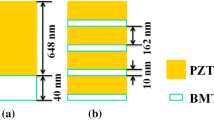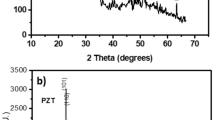Abstract
In this paper, Pb(Zr0.52Ti0.48)O3 (PZT) thin films were prepared on Pt/Ti/SiO2/Si substrates via sol–gel method. The effects of residual stress on the electrical properties in PZT thin films were investigated. There is no significant difference in grain size and orientation for PZT thin films, indicating that the influences of grain size and orientation on electrical properties of PZT thin films can be neglected. The residual stresses in PZT thin films, which decrease with increase in the film thickness, were detected by the phonon mode shift of Raman scattering. In the thin films, the interface between PZT thin films and platinum electrodes is the main factor that affected dielectric properties. As the film thickness increases, the contribution of the interface is increasingly attenuated and the residual stress is the main factor. To relieve some of the residual stress, there are more 90° domains to form, which can improve the ferroelectric and piezoelectric properties of PZT thin films.
Graphical Abstract
The value of dielectric constants decreases at 1 MHz, and tan δ increases with the decrease in film thickness. In this paper, the processing was designed to control grain size and crystal orientation. Therefore, residual stress and interface are the main factors that affect the dielectric constant. For the sample with the thickness of 162 and 324 nm, there is a ~45 % increase in measured dielectric constant and this change appears to be too much to be accounted for by the residual stress alone. The main factor that affects dielectric constant in the thinner films is the interface which can dilute the effective dielectric constant. As the film thickness increases, the contribution of the interface is increasingly attenuated and there is only 4 % change in the dielectric constant, indicating that residual stress is the main factor that affected dielectric constant.

Dielectric constants and tan δ as a function of frequency for PZT thin films with different thickness







Similar content being viewed by others
References
Wen BH, Zhang Y, Liu X, Ma L, Wang X (2013) Ceram Int 39:219–225
Suzuki T, Kanno I, Loverich JJ, Kotera H, Wasa K (2006) Sens Actuators A 125:382–386
Xu WH, Lu D, Zhang TY (2001) Appl Phys Lett 79:4112–4114
Berfield TA, Ong RJ, Payne DA (2007) J Appl Phys 101:024102
Ong RJ, Payne DA, Sottos NR (2005) J Am Ceram Soc 88:2839–2847
Zheng XJ, Li JY, Zhou YC (2004) Acta Mater 52:3313–3322
Desu SB (1994) Phys Status Solidi A 141:119–133
Lappalainen J, Franti J, Lantto V (1997) J Appl Phys 82:3469–3477
Lian L, Sottos NR (2004) J Appl Phys 95:629–634
Randall CA, Kim N, Kucera JP, Cao W, Shrout TR (1998) J Am Ceram Soc 81:677–688
Pintilie L, Pasuk I, Negrea R, Filip LD, Pintilie I (2012) J Appl Phys 112:064116
Fu D, Suzuki H, Ogawa T, Ishikawa K (2002) Appl Phys Lett 80:3572–3574
Wolf RA, Trolier-McKinstry S (2004) J Appl Phys 95:1397–1406
Begg BD, Finnie KS, Vance ER (1996) J Am Ceram Soc 79:2666–2672
Ohno T, Matsuda T, Ishikawa K, Suzuki H (2006) Jpn J Appl Phys 45:7265–7269
Lee JH, Hwang KS, Kim TS (2010) Appl Phys Lett 96:092904
Yi H, Kim MG, Park JH, Jang HM (2004) J Appl Phys 96:5110–5116
de la Cruz JP, Joanni E, Vilarinho PM, Kholkin AL (2010) J Appl Phys 108:14106
Kanno I, Yokoyama Y, Kotera H, Wasa K (2004) Phys Rev B 69:064103
Liu DG, Wang C, Zhang HX, Li JW, Zhao LC, Bai CL (2001) Surf Interface Anal 32:27–31
Warren WL, Dimos D, Tuttle BA, Pike GE, Raymond MV, Nasby RD, Ramesh R, Evans JT (1995) Mater Res Soc Symp Proc 361:51–57
Stancu V, Lisca M, Boerasu I, Pintilie L, Kosec M (2007) Thin Solid Films 515:6557–6561
Acknowledgments
This work was financially supported by National Natural Science Foundation of China (Grant Nos. 51072148 and 51102191), Wuhan Scientific and Technological Project (Grant No. 2013010501010137), and the Fundamental Research Funds for the Central Universities of Ministry of Education of China (Grant No. 2012-II-016).
Author information
Authors and Affiliations
Corresponding author
Rights and permissions
About this article
Cite this article
Wu, Z., Zhou, J., Chen, W. et al. Effects of residual stress on the electrical properties in PbZr0.52Ti0.48O3 thin films. J Sol-Gel Sci Technol 75, 551–556 (2015). https://doi.org/10.1007/s10971-015-3725-1
Received:
Accepted:
Published:
Issue Date:
DOI: https://doi.org/10.1007/s10971-015-3725-1




